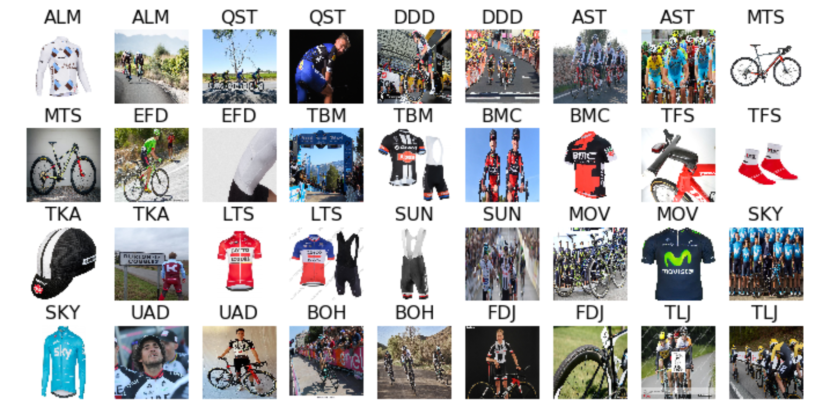
My last blog explored the effectiveness of deep learning in spotting the difference between Vincenzo Nibali and Alejandro Valverde. Since the faces of the riders were obscured in many of the photos, it is likely that the neural network was basing its evaluations largely on the colours of their team kit. A natural next challenge is to identify a rider’s team from a photograph. This task parallels the approach to the kaggle dog breed competition used in lesson 2 of the fast.ai course on deep learning.
Eighteen World Tour teams are competing this year. So the first step was to trawl the Internet for images, ideally of riders in this year’s kit. As before, I used an automated downloader, but this posed a number of problems. For example, searching for “Astana” brings up photographs of the capital of Kazakhstan. So I narrowed things down by searching for “Astana 2018 cycling team”. After eliminating very small images, I ended up with a total of about 9,700 images, but these still included a certain amount of junk that I did have the time to weed out, such as photos of footballers or motorcycles in the “Sky Racing Team”,.
The following small sample of training images is generally OK, though it includes images of Scott bikes rather than Mitchelton-Scott riders and a picture of Sunweb’s Wilco Kelderman labelled as FDJ. However, with around 500-700 images of each team, I pressed on, noting that, for some reason, there were only 166 of Moviestar and these included the old style kit.

For training on this multiple classification problem, I adopted a slightly more sophisticated approach than before. Taking a pre-trained Resnet50 model, I performed some initial fine-tuning, on images rescaled to 224×224. I settled on an optimal learning rate of 1e-3 for the final layer, while allowing some training of lower layers at much lower rates. With a view to improving generalisation, I opted to augment the training set with random changes, such as small shifts in four directions, zooming in up to 10%, adjusting lighting and left-right flips. After initial training, accuracy was 52.6% on the validation set. This was encouraging, given that random guesses would have achieved a rate of 1 in 18 or 5.6%.
Taking a pro tip from fast.ai, training proceeded with the images at a higher resolution of 299×299. The idea is to prevent overfitting during the early stages, but to improve the model later on by providing more data for each image. This raised the accuracy to 58.3% on the validation set. This figure was obtained using a trick called “test time augmentation”, where each final prediction is based on the average prediction of five different “augmented” versions of the image in question.
Given the noisy nature of some of the images used for training, I was pleased with this result, but the acid test was to evaluate performance on unseen images. So I created a test set of two images of a lead rider from each squad and asked the model to identify the team. These are the results.

The trained Resnet50 correctly identified the teams of 27 out of 36 images. Interestingly, there were no predictions of MovieStar or Sky. This could be partly due to the underrepresentation of MovieStar in the training set. Froome was mistaken for AG2R and Astana, in column 7, rows 2 and 3. In the first image, his 2018 Sky kit was quite similar to Bardet’s to the left and in the second image the sky did appear to be Astana blue! It is not entirely obvious why Nibali was mistaken for Sunweb and Astana, in the top and bottom rows. However, the huge majority of predictions were correct. An overall success rate of 75% based on an afternoon’s work was pretty amazing.
The results could certainly be improved by cleaning up the training data, but this raises an intriguing question about the efficacy of artificial intelligence. Taking a step back, I used Bing’s algorithms to find images of cycling teams in order to train an algorithm to identify cycling teams. In effect, I was training my network to reverse-engineer Bing’s search algorithm, rather than my actual objective of identifying cycling teams. If an Internet search for FDJ pulls up an image of Wilco Kelderman, my network would be inclined to suggest that he rides for the French team.
In conclusion, for this particular approach to reach or exceed human performance, expert human input is required to provide a reliable training set. This is why this experiment achieved 75%, whereas the top submissions on the dog breeds leaderboard show near perfect performance.

One thought on “Which team is that?”